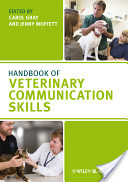Handbook of Veterinary Communication Skills

A textbook on veterinary communication. This book covers key areas of communication including: the basic framework for the veterinary consultation; professional, ethical and legal aspects; communication with clients and colleagues; and coping with end-of-life and other difficult situations. It combines research with practical information.
Autor: Gray
| Nakladatel | Plot |
|---|---|
| ISBN | 9781405158176 |
| Vydání | 2010 |
| Vazba | brožovaná |
| Počet stran | 198 |
This is the first definitive textbook on veterinary communication, written specifically for students and veterinary professionals by a group of international experts. Communication is a core clinical skill, and is now taught as a compulsory part of most veterinary degree courses. Good communication is crucial to the veterinarian-client-patient relationship, to patient health and ultimately to the success of any veterinary business. The book covers all the key areas of communication including: the basic framework for the veterinary consultation; professional, ethical and legal aspects; communication with clients and colleagues; and coping with end-of-life and other difficult situations. It combines the most up-to-date research with a wealth of practical information, such as: real-life case studies to help you apply your learning to real scenarios; simple step-by-step guidelines showing you how to deal with specific situations; and examples of written resources you can use in practice. This valuable textbook has been written and edited by a carefully chosen group of specialists, comprising veterinary communication lecturers, veterinary practitioners, training managers and counsellors.
| Chapter 1 Basic communication skills Mary Kirwan | 1 |
| Introduction | 1 |
| Background and origins | 1 |
| The importance of communication | 2 |
| Definition of key terms | 3 |
| Models of communication | 4 |
| Verbal and non-verbal communication | 7 |
| Listening | 15 |
| The cultural context of communication | 21 |
| Summary | 22 |
| References | 22 |
| Chapter 2 A framework for the veterinary consultation Alan Radford | 25 |
| Introduction | 25 |
| A guide to the veterinary consultation based on the calgary-Cambridge observation guide | 27 |
| The physical examination | 37 |
| Closing the consultation | 37 |
| Summary | 38 |
| References | 38 |
| Chapter 3 Professional, ethical and legal aspects of communication Carol Gray | 39 |
| Introduction | 39 |
| Communicating professionalism | 39 |
| Gathering information from clients | 41 |
| Giving information to clients | 42 |
| Informed consent | 47 |
| References | 59 |
| Chapter 4 Compassionate communication: Working with grief Susan Elizabeth Dawson | 62 |
| Introduction | 62 |
| The HCAB | 63 |
| Review of quality-of-life indicators | 93 |
| Setting up and running continuing care clinics | 95 |
| PET loss support groups | 96 |
| CPD opportunities | 97 |
| Resources and useful websites | 97 |
| References | 98 |
| Chapter 5 Dealing with difficult situations Carol Gray and Jenny Moffett | 100 |
| Introduction | 100 |
| The use of veterinary communication skills at the end of life | 100 |
| A seven-step approach to communication at end-of-life | 102 |
| Euthanasia - before, during and after | 105 |
| Welfare concerns | 109 |
| Informed clients | 110 |
| Communicating cost | 112 |
| Dealing with anger | 115 |
| Communication of mistakes | 118 |
| References | 122 |
| Chapter 6 Communicating with colleagues Geoff Little | 127 |
| Introduction | 127 |
| The team and its leader | 128 |
| Induction schemes and mentoring | 131 |
| Appraisals | 132 |
| Exit interview | 133 |
| Delegation | 134 |
| Standard operating procedures | 136 |
| Staff suggestion scheme | 139 |
| Practice meetings | 142 |
| Reporting structure | 144 |
| Rotas | 145 |
| Interpractice communication | 145 |
| References | 147 |
| Chapter 7 Communicating with a wider audience Jenny Moffett | 149 |
| Public speaking for beginners | 149 |
| Veterinary medicine and the media - a meeting of two worlds | 155 |
| References | 166 |
| Chapter 8 Communication and self-care in the veterinary profession | 168 |
| Communication, Stress and the Individual Martina A. Kinsella | 168 |
| The first step to inner freedom | 169 |
| Moving from victim to victor | 170 |
| Implementing change | 171 |
| Learning assertiveness skills and becoming an assertive individual | 173 |
| Beyond words: Communication, social relationship and health David Bartram | 176 |
| The disclosure phenomenon | 177 |
| Importance of social relationships | 180 |
| The role of telephone support helplines | 183 |
| Summary and conclusions | 185 |
| Acknowledgements | 185 |
| References (Communication, Stress and the Individual) | 185 |
| Further Reading (Communication, Stress and the Individual) | 185 |
| References (Beyond words: Communication, social relationships and health) | 186 |
| Index | 190 |